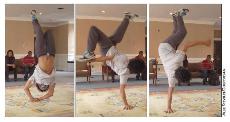Gathered around the “Godfather of hip-hop,” students undulated to the unique sounds of DJ Kool Herc’s beats. Suddenly, five breakers split through the swaying crowd, each taking turns displaying their moves. The crowd circled around them, cheering the b-boys and b-girl on with steady, rhythmic claps-opening Winston-Salem State University’s second annual “Hip-Hop is Reality” summit. On Feb. 10, in celebration of Black History Month, at Guilford’s first brown bag series discussion, Interim Africana Community Coordinator Jada Drew introduced Winston-Salem State’s Campus Life Marketing and Promotional Director Chelii Broussard to the intimate group.
During the informal discussion, in addition to sharing her experiences with hip-hop, as well as a breaking demonstration, Broussard also discussed the Feb. 13 “Hip-Hop is Reality” summit. The summit was developed by Broussard to inform the community on political issues facing hip-hop music and culture, as well as to redirect negative views and stereotypes associated with hip-hop.
Broussard opened the discussion detailing the origins of her love affair with the genre of music.
“Growing up in Seattle, Wash., I started out listening to rock music. Bon Jovi, Def Leppard, Led Zeppelin,” said Broussard. “I don’t remember anything about hip-hop until I came to North Carolina and first heard (the Doug E. Fresh song) ‘La Di Da Di’.”
She reminisced about the first hip-hop dance she learned, which she was apparently terrible at, the first song with a message that really moved her, and her first hip-hop gig working at Greensboro’s 102 Jams radio station.
Along with her love for the music, Broussard expressed her disappointment with the direction in which hip-hop is going. According to Broussard, radio stations perpetuate the negative perceptions of hip-hop by playing music by rap artists who exploit the culture.
“First they murdered my heart. 102 Jams is the hip-hop station, but you don’t hear real hip-hop. I stopped working there two years ago. (Quitting 102 Jams) became my first awakening, telling me that I needed to learn more,” said Broussard.
The commercialization and misogynistic themes of modern rap music has led Broussard to question her love of the music.
“I don’t watch BET or MTV or late night TV because it’s scary. Hip-hop has become commercial misogyny. You can’t look at commercials and music videos without watching girls poppin’ their butts,” said Broussard. “Hip-hop is being raped as everything it started out as. That’s why I’ve gotta decide if I’m gonna love hip-hop or hate hip-hop.”
As the discussion progressed, Broussard introduced the five basic elements that embody the hip-hop movement: the DJ, MC, Breaking, Graffiti, and Beat Boxing.
The MC is an artist who raps to impact people with well written, crisply-delivered, clear and concise lyrics.
Beat boxing is the vocal percussion of hip-hop culture and music. It is primarily concerned with the art of creating beats, rhythms, and melodies using the mouth.
Graffiti is the eccentric application of graphics on surfaces that are publicly viewed.
“Graffiti is still very underground,” said Broussard. “A lot of artists don’t want to be known. I look at it as a form of street art, expressing yourself in a raw form.”
Breaking is a street-based dance that includes synchronized body movements, coordination, style and aesthetics. The people who perform this style of dance are known as b-boys and b-girls. This style of dance is also derived from the “break” in the beat played by the DJ.
“It’s all about love. Breaking started with young kids, the younger brothers of gang members in the 1960’s. They wanted to stop the negativity, bringing fighting and killing to a more positive context,” said Broussard.
The beginnings of DJing did not necessarily start in the United States. A famous hip-hop pioneer, DJ Kool Herc, moved to New York in the late 1960’s from Jamaica. He brought with him the Jamaican tradition of “toasting,” which involved reciting improvised rhymes over instrumental sections of reggae records. Herc paved the way for the creation of many different mixing styles.
“In New York there are many different boroughs with culture,” said Broussard. “Kool Herc would have parties in Brooklyn and would set up in the middle of the block. He would set up the mic and do his thing.”
Broussard concluded her discussion by encouraging the attendees to further educate themselves on the hip-hop culture by attending the “Hip-Hop is Reality” summit where DJ Kool Herc would be guest speaking.
At Friday’s summit, DJ Kool Herc was introduced by North Carolina A&T University’s humanities lecturer Bryan Turman. Turman discussed how hip-hop originated from the extended breakbeat credited to Herc.
“Hip-hop is an everybody thing,” said Turman. “In a block party you can’t tell the white kid he can’t come. You can’t tell the Hispanic, the homosexual, the woman, et cetera. Herc created what became known as hip-hop. The first one to anything is always the last to gain recognition.”
In his interview with noted hip-hop scholar and activist Bakari Kitwana, Herc discussed the origins of hip-hop in the climate of 1970’s New York City.
“There was poverty and desperation,” said Herc. “The scene that brought about the beginning of hip-hop was out of love. Gangs were tearing apart the clubs. People were getting hurt.”
The interview moved towards the issue of hip-hop’s role in today’s culture.
“Hip-hop is still going strong, just people are misusing it,” said Herc. “It’s your job to change that and bring the swagger back. Hip-hop today has too much scattered power, too much misuse of those that look like me and you. We all come from the same place; why beat me up when we look like each other?”

